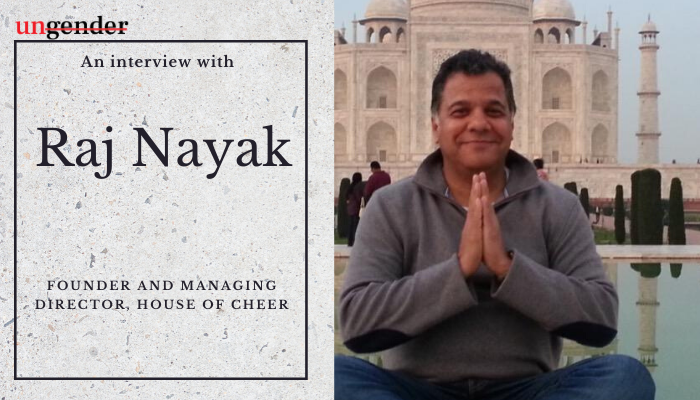Diversity and Inclusion Give Meaning to Profits – Says Raj Nayak, Head- House of Cheer

Note from the Editor: Ungender Insights will now feature an occasional longform feature from industry leaders or the blog team. This series is a new addition to the blog. We believe that longform content is important for our area of work and also relevant to readers who value insight on topics that are often complicated, nuanced and take time to grasp. While it is absolutely true that we are living in the instant-gratification age of short attention spans – we think it is important to sometimes present the “whole story”. We hope you enjoy these pieces.
This interview has been edited for longform text
Written By Rituparna Chatterjee, 🖊 edited by Varna
Raj Nayak, former Viacom18 chief operating officer, hosts Facebook Live sessions with celebrities on Fridays. The conversation is free flowing and he insists there’s no pre-decided structure to the questions, which allows his guests to open up about aspects of their lives they wouldn’t otherwise easily share. In a similar conversation with Ungender Legal Advisory’s Rituparna Chatterjee, Nayak, who now heads a media and entertainment company called House of Cheer, spoke about the feminist discourse and how it plays into every aspect of someone’s work, starting at the top. Nayak, former Colors channel CEO, also spoke about the important role gender roles and patriarchy plays in determining popular content.
Q: How important is the leadership role in building holistic, diverse teams?
A: The most important thing for a leader is to be approachable, whether it is an elected leader or a CEO. If you are not approachable then you have a challenge. You are not getting feedback, which you will only get through systems that get filtered at various points.
I have always had an open-door policy at Viacom. Anybody could walk in, and they did not even need an appointment. But the truth is very few people walked in. Half the time, it is about knowing that, “I can walk in.” The comfortable thought, that the person is there for me to talk to, was enough to change the whole scenario. Some people would feel obligated to come only if it is something really important but I also had people coming in just for a chat.
Q: What difference does being seen as approachable make to a team?
A: People already know that, “my speaking to my boss or super boss will not necessarily resolve my issues”, I cannot solve everybody’s problem. But people do feel good when they are heard. Half the times when you vent, you want someone to listen to you. Sometimes, I don’t have a solution and I tell them that. I also tell them that if I were in your place, this is what I would do. Sometimes, I find a solution. Approachable culture is very important for any leader in any organization.
For instance, at ‘House of Cheer’, the cabins have no doors.
Q: How does inclusion and equal representation affect the way you work?
A: For any kind of diversity, you need to be more inclusive. In India especially gender equity has never been there. We’ve been a patriarchal society. This imbalance has happened over hundreds of years and at some point that balance has to come back. From a work point of view, when you have gender diversity, people bring in different perspectives. My way of looking at life, my experience is completely different from yours, being a woman — the way you look at life and the way you experience life.
So, when you have people with different diversity sitting in the same room, there are more ideas, thoughts and views coming in, and I think there’s a healthier collaboration that happens. It is true that when there are men and women in the room, you’ll see that the chemistry and the collaboration is much more. When there’s only men then you will see there’s a competition.
Q: Are you saying women are not competitive?
A: No, no. Being competitive is only one thing. With women there’s also better collaboration, better ideas, better views, different perspectives that come to the centre.
Q: Would you say you’re a male ally to the feminist discourse?
A: I don’t know, but I genuinely feel strongly about it. A lot of that has to do with me having two daughters and they are the ones who are educating me. I wasn’t like this 10 years ago or fifteen years ago.
Awareness and choice of words are important. I think one way of making sure that the world becomes a better place is for people to bring in awareness, and you as an individual can contribute to generating awareness in your own little ways.
Q: You have spoken up about all male panels, or ‘manels’ as we call them. You’ve refused to be part of one when your daughter told you what they are. What would you tell other men when they are invited to manels, because when men speak, other men listen. What would you say they can do differently? And what does the visual representation of a manel convey?
A: First of all, I disagree with you when you say when men speak, men listen. I say women also speak and men listen. But honestly there aren’t enough women in positions of power, or women in leadership positions to speak, that’s the challenge. About manels, I’m guilty of it. Until my daughter pointed it out to me, it didn’t even cross my mind. So, somebody made me aware and in my own little way I’m trying to make the world aware.
I was called on a webinar just a few days ago, and I saw it after accepting that there were no women (speakers) and I wanted to drop out for this reason. The organiser told me that 2 or 3 women had confirmed but dropped out at the last moment. He apologized right at the beginning to the audience. And so, I said, “fine.” Change happens slowly and as long as it happens, and it’s moving in the right direction, it is fine.
Maybe, it isn’t happening at the speed at which it should happen. So, I would tell other men to be aware of this and ask your host to find women speakers. If the host comes back and says, nobody agreed to come on the panel, then you should recommend people.
Q: You’ve been with Colors so you know how content works for the visual media. How important a role do you think pop culture plays in influencing gender roles and gender representation?
A: There are challenges for broadcasters and content creators. I think it all stems from patriarchy. For example, if there are guests at home, your sister is supposed to carry the coffee tray or the water and not your brother. You know, it’s all the stereotypes that have been built in. Half the problem is, the women also grow up learning them. This stuff is taught to the girl child by default or by intentional design. I have found people who appear to be very progressive and liberal and yet following these stereotypes. This has to change right from childhood, right from schooling.
Coming back to content, I think it is very important because visually what you see stays with you. I’ll tell you the challenges also for a broadcaster – there is an urban audience and there’s a rural audience. Now suddenly, if we show something completely different (that they are unaccustomed to seeing), audiences may say “aisa toh nahi hota hai” Because their mindset is different. That culture is different and not necessarily rural. Even in urban areas, a lot of households will suddenly say, “no, this is not this can’t happen. This is not real. It’s unrealistic.” So, a change has to happen in society too, it can’t be only media-led.
I think people are trying, it’s not that people are not trying there, but it’s not happening. You need to bring in women into content creation. Right now, the majority is male. When you have male directors, male writers, what happens is that it is the male’s eye that is looking at things, but when you bring up women and if you have more women producing movies, their sensibilities will come to play and they will look at content from a different angle. There is a male gaze to content, definitely, what is an item number if it’s not a male gaze?
Q: The idea of a seat at the table — women have to work twice as hard to achieve what men achieve. How has this changed in the past decades?
A: When you see a manel with no women on it, then women might feel there is no aspiration for them, they cannot see another woman leader. You need role models, icons. And having just one, say Indira Nooyi somewhere, or a Kiran Mazumdar Shaw, is not enough. Secondly, look at women’s representation. We said we need 33% reservation for women in the parliament, and I think that bill has been given to successive governments, but nobody’s passed it. There should be a representation of 33% women, minimum as a rule. In fact, I’m saying it should be 50% but given that today, it is so low, we can start somewhere.
A company can have the highest profits and everything, but if it doesn’t tick the box of gender diversity, or inclusivity, then all that has no meaning.
Q: How have mindsets changed on traditional gender roles?
Nowadays, for example, when the husband changes diapers or looks after the baby, women often themselves say, “oh, my husband was babysitting today” but isn’t it his baby too? I have a problem with ‘maternity’ and ‘paternity’ leave. I think it should be ‘parental’ leave.
What happens is, once the baby’s born, for the first six months or so, the mother spends all the time with the baby, looking after its needs. Then when the husband takes care of it, he finds that he doesn’t really know the habits of his own baby. That is why parental leave should start right from the time a baby is born.
Q: What can companies do differently to have more gender representation?
A: It has to percolate from the top, first of all. The CEO of the company, and if it is a man, his actions will determine what percolates down. Whatever is it that you want to implement. There has to be a more sustained campaign. There has to be representation in the governments in doing things. It’s not going to be an easy thing. But I feel proud that in spite of all that we do, we still have (had) a woman Prime Minister in this country. So, in spite of everything, there is hope.
I think it’s mandatory now that in a board, you need a woman director, in an organization. Change is happening. It will be interesting to know in organizations where women are in senior roles or at the top, what is the gender diversity? What is the composition?
Q: What are the core ideals on which House of Cheer runs?
A: Very simple! The name itself signifies happiness. So, anything that makes us happy, and anybody whose lives we touch, or whoever works with us, we need to make everybody happy. That’s our thing. At the end of the day, I think that’s the ultimate everybody aspires for – happiness, and there’s nothing beyond that.
In fact, we even have a joke — we’ll put a board outside our office saying “please walk in only if you carry happiness, money, ideas, contacts, or a smile.” Because happiness is contagious, we would want to spread that cheer.
About the author: Rituparna Chatterjee is a journalist with close to two decades of experience in journalism, working across media platforms, and tracking ground-up stories of feminist movements, social inequalities, gaps in gender discourse, and communities. She currently oversees communications for Ungender Legal Advisory
Ungender Insights is the product of our learning from advisory work at Ungender. Our team specializes in advising workplaces on workplace diversity and inclusion. Write to us at contact@ungender.in to understand how we can partner with your organization to build a more inclusive workplace.
Read our insights about diversity, legal updates and industry knowledge on workplace inclusion at Ungender Insights. Visit our Blog.
Sign up to stay up-to-date with our free e-mail newsletter.
The above insights are a product of our learning from our advisory work at Ungender. Our Team specialises in advising workplaces on gender centric laws.
or email us at contact@ungender.in




